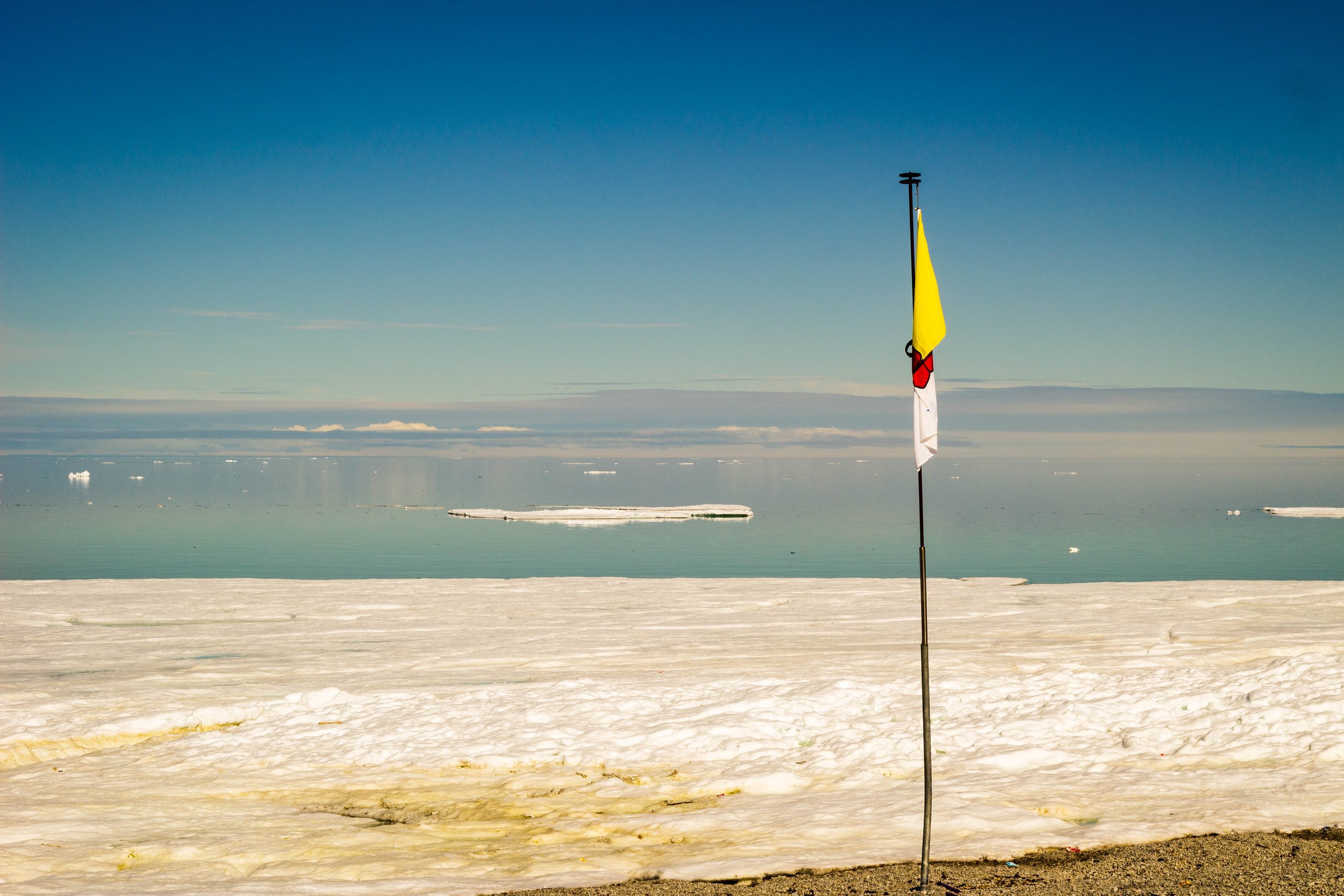
ᓴᓂᕋᔭᖕᒥᑦ ᐆᒻᒪᖅᑯᑎᓕᕆᓂᕐᒧᑦ ᓯᕗᓂᒃᓴᑦᑎᓐᓂᒃ
ᒪᑐᐃᖓᑎᑦᑎᔪᑦ
ᑐᙵᓱᒃᑎᑉᐸᔅᓯ ᐃᓕᑦᑎᒃᑲᓐᓂᖁᓪᓗᓯ ᐊᑐᒃᑲᓐᓂᕈᓐᓇᖅᑐᓂᒃ ᐆᒻᒪᖅᑯᑎᓂᒃ ᐱᕕᒃᓴᓂᒡᓗ ᓴᓂᕋᔭᖕᒧᑦ. ᑐᓴᕈᒪᔪᒍᑦ ᖃᓄᖅ ᐃᓱᒪᖕᒪᖔᖅᐱᑦ ᓄᓇᕗᑦ ᓄᒃᑭᒃᓴᐅᑏᑦ ᑯᐊᐳᕇᓴᒃᑯᑦ ᖃᐅᔨᓇᓱᒃᑲᓐᓂᓪᓗᐊᕐᓂᖏᓐᓂᒃ ᓄᓇᔅᓯᓐᓄᑦ. ᐃᓱᒪᖅᓲᑎᒋᒐᕕᐅᒃ.
Sanirajak’s Energy Future
Open House
We invite you to learn more about Nunavut Nukkiksautiit Corporation (NNC), renewable energy, and the opportunities in Sanirajak.
ᒪᑐᐃᖓᑎᑦᑎᔪᑦ
Open House
ᐅᓪᓗᖓ: ᓄᕕᐱᕆ 18, 2023
ᓯᕿᕐᖑᔭᖅ: 1:30-ᒥᑦ-8:30-ᒧᑦ ᐅᓐᓄᒃᑯᑦ
ᐅᖃᓪᓚᒃᑐᖃᕐᓂᐊᖅᑐᑦ ᑲᑎᒪᔪᓄᑦ: 2:30 ᐅᓐᓄᓴᒃᑯᑦ / 7:00 ᐅᓐᓄᓴᒃᑯᑦ
ᐃᓂᖓ: ᐊᕐᓇᕐᔪᐊᑉ ᐃᓕᓐᓂᐊᕐᕕᐅᑉ
Date: November 18th, 2023
Time: 1:30PM – 8:30PM
Presentations at: 2:30pm / 7:00pm
Place: Arnaqjuaq School Gym
ᓄᓇᓕᖕᓂᑦ
ᐃᖏᕐᕋᑎᑕᐅᔪᖅ
ᓄᓇᕗᑦ ᓄᒃᑭᒃᓴᐅᑏᑦ ᑯᐊᐳᕆᓴᓐ ᑕᐃᒪᖓᓂᑦ ᕿᓂᓲᑦ ᑖᒃᑯᐊ ᐃᓄᐃᑦ ᐊᒻᒪᓗ ᐃᓄᐃᑦ ᐊᐅᓚᑦᓯᔨᖏᑦ ᓇᖕᒥᓂᖃᖅᑎᐅᓂᐊᕐᒪᑕ ᐊᒻᒪᓗ ᐃᑲᔫᓯᐊᖃᑦᑕᕐᓗᑎᒃ ᓄᓇᒥᑦ ᐆᒻᒪᖁᑎᖃᐅᑎᖃᕐᕕᖕᒥᖕᓄᑦ.
ᑕᐃᒪᓐᓇᐅᒍᓂ, ᓄᓇᒥᑦ ᐆᒻᒪᖁᑎᖃᕐᑎᑦᑎᓂᖅ ᖃᐅᒪᑎᑦᑎᔪᓐᓇᖅᑐᖅ ᐃᑯᒪᑎᑦᑎᓗᓂ ᐃᓄᐃᑦ ᓄᓇᖏᓐᓂᒃ ᐊᒻᒪᓗ ᑮᓇᐅᔭᓕᐊᖏᑦ ᑕᒪᑐᒪᖓ ᑕᐃᑲᓃᖏᓐᓇᕐᓗᑎᒃ. ᓄᓇᕗᑦ ᓄᒃᑭᒃᓴᐅᑏᑦ ᑯᐊᐳᕆᓴᓐ ᕿᓂᕐᓂᐊᖅᑐᑦ ᓄᓇᓕᖕᓄᑦ ᐊᖏᖅᑕᐅᔪᒪᓗᓯᑎᒃ ᓇᓕᐊᑐᐃᓐᓇᒥᒃ ᓄᓇᒥᑦ ᐆᒻᒪᖁᑎᖃᐅᑎᒋᔪᒪᔭᒥᖕᓂᒃ ᓂᕈᐊᕆᓯᒪᔭᒥᖕᓄᑦ.
Community Led
NNC is looking at ways that Inuit and Inuit organizations can be the owners and benefactors of renewable energy.
This way, renewable energy can power Inuit communities and the profits stay there. NNC will look to the community for consent on any renewable projects chosen.
ᐱᓕᕆᔭᐅᕙᓪᓕᐊᓂᖓᑕ ᐱᒋᐊᕐᓂᖓ
Phased Approach
ᓴᓂᕋᔭᖕᒥ ᓄᒃᑭᒃᓴᐅᑎᓕᕆᓂᕐᒧᑦ ᐱᓕᕆᐊᓄᑦ ᖃᓄᐃᓕᐅᕈᑎᐅᔪᑦ ᐱᓕᕆᐊᖑᕙᓪᓕᐊᕋᐅᔭᕐᓗᓂ ᐱᕙᓪᓕᐊᑎᑕᐅᓗᓂ. ᐊᑐᖅᓯᖃᑦᑕᖅᑐᑦ ᑕᐃᒪᓐᓇ ᐱᒋᐊᕈᑎᖃᖅᖢᑎᒃ, ᑕᒪᑐᒥᖓ ᐃᓄᐃᑦ ᐊᖏᖅᓯᒪᔪᑦ ᑎᓴᒪᐃᖅᖢᑎᒃ. ᐅᓇ ᑕᓪᓕᒪᖓ ᐱᓕᕆᔭᐅᕙᓪᓕᐊᓂᖓ ᓴᓇᔭᐅᔪᖅ ᐅᑯᓂᖓ ᐃᓚᖃᖅᑐᖅ:
The Sanirajak Nukkiksautiit Project functions within a phase-gate system of project development. Using this approach, Inuit say yes four times. The five phases of the project include:
ᐊᕙᑖᓂᑦ ᐊᑐᓂ ᐱᓕᕆᔭᐅᕙᓪᓕᐊᓂᖓ ᓯᕗᒃᑲᖅᑕᕐᓂᖓ, ᐃᓱᒪᓕᐅᕆᕕᖃᖃᑦᑕᖅᑐᑦ. ᐅᓇ ᐱᒋᐊᕐᕕᖓᑦ ᓄᖃᖓᑎᑦᑎᓚᐅᑲᓲᖅ ᐃᓄᐃᑦ ᐱᔪᓐᓇᐅᑎᖃᖅᑐᑦ ᐃᓱᒪᓕᐅᕆᓂᐊᕐᒪᑕ ᐅᕝᕙᓘᓐᓃᑦ ᑲᔪᓯᑎᑦᑎᔪᒪᓐᖏᑉᐸᑕ ᑖᓐᓇ ᓴᓇᔭᐅᔪᖅ ᐱᕚᓪᓕᖅᐸᓪᓕᐊᓂᐊᕐᒪᖔᑦ ᐱᖃᑖᓄᖅ ᐱᓕᕆᔭᐅᕙᓪᓕᐊᓂᕆᓂᐊᖅᑕᖓᓄᑦ.
Between each phase, there is a decision gate. This gate offers a pause for Inuit Rightsholders to decide whether or not the project should advance to the next phase.
ᐱᓕᕆᔭᐅᕙᓪᓕᐊᓂᖓᑕ ᐱᒋᐊᕐᓂᖓ
Sanirajak Renewable Energy Project Options
ᐊᓄᕆᑐᐊ
ᐃᒃᑭᖐᔭᖅᓯᒪᔪᖅ (ᐊᓄᕆ + ᓯᕿᓂᕐᒥᑦ)
ᓯᕿᓂᖕᒨᖅᑐᑐᐊᑦ
Wind Only
Hybrid (Solar + Wind)
Solar Only
ᐃᑲᔫᑎᑦ
Resources
ᐊᑏ ᐊᑐᕐᓗᒋᑦ ᑖᒃᑯᐊ ᐃᑲᔫᑎᑦ ᖃᐅᔨᒋᐊᒃᑲᓐᓂᕐᓗᑎᑦ ᑕᒪᑐᒥᖓ ᓄᓇᒥᑦ ᐆᒻᒪᖁᑎᖃᕐᑎᑦᑎᓂᕐᒥᒃ, ᓄᓇᕗᑦ ᓄᒃᑭᒃᓴᐅᑏᑦ ᑯᐊᐳᕆᓴᓐ, ᐊᒻᒪᓗ ᐊᔪᕐᓇᖏᑦᑐᑦ ᓄᓇᕗᒻᒥ!
Please use these resources to find out more about renewable energy, NNC, and the possibilities in Nunavut!
-

ᐅᖃᓕᒫᒐᖅ
Brochure
-

ᐊᔾᔨᖑᐊᓕᑦ ᑎᑎᖃᑦ ᐊᑭᐊᕐᒥᐅᑕᐃᑦ
Event Posters
FAQs
ᐊᐱᖁᑕᐅᒐᔪᓲᑦ
-
ᓴᓂᕋᔭᒃ ᓄᒃᑭᒃᓴᐅᑏᑦ ᐱᓕᕆᐊᖅ ᕿᒥᕐᕈᔪᑦ ᖃᓄᐃᑦᑐᓂᑦ ᐊᑐᒃᑲᓐᓂᕈᓐᓇᖅᑐᓂᑦ ᐆᒻᒪᖅᑯᑎᓂᑦ ᐊᑐᕐᑕᐅᔪᓐᓇᖕᒪᖔᖏᑦ ᓴᓂᕋᔭᖕᒥᑦ. ᕿᒥᕐᕈᔪᑦ ᐃᓄᐃᑦ ᐃᓄᐃᓪᓗ ᑲᑐᔾᔨᖃᑎᒌᖏᑦ ᓇᖕᒥᓂᖃᕈᓐᓇᕐᓗᑎᒃ ᓴᓇᔪᓐᓇᕐᓗᑎᒡᓗ ᐊᑐᒃᑲᓐᓂᕈᓐᓇᖅᑐᓂᑦ ᐆᒻᒪᖅᑯᑎᓂᑦ, ᐊᑐᒃᑲᓐᓂᕈᓐᓇᖅᑐᓂᑦ ᐆᒻᒪᖅᑯᑎᓂᑦ ᓄᓇᓕᖕᓂᑦ, ᑮᓇᐅᔭᓂᒡᓗ ᓴᖅᑭᑉᐸᓪᓕᐊᔪᑦ ᐊᑐᒃᑲᓐᓂᕈᓐᓇᖅᑐᓂᑦ ᐆᒻᒪᖅᑯᑎᓂᑦ ᓄᓇᓕᖕᓃᖏᓐᓇᕈᓐᓇᖁᓪᓗᒋᑦ.
-
ᑐᕌᕆᔭᐅᓪᓗᐊᑕᖅᑐᖅ ᓴᓂᕋᔭᖕᒥ ᓄᒃᑭᒃᓴᐅᑏᑦ ᐱᓕᕆᐊᕆᔭᖓᓂ ᓴᓇᙳᐊᕈᒪᓪᓗᑎᒃ ᓴᓂᑭᓗᐊᕐᒥᐅᓄᑦ ᐊᑐᓗᐊᕈᓐᓃᖅᑎᑦᑎᔪᒪᓪᓗᑎᒃ ᐅᖅᓱᐊᓗᖕᒥᒃ ᐊᔪᕐᓇᙱᓐᓂᓕᒫᖓᒍᑦ. ᐃᒐᓯᐅᒻᒥᒃ ᐃᑭᑎᑦᑎᓂᖅ ᐆᒻᒪᖅᑯᑎᓕᐅᕐᓂᐊᕐᓗᓂ ᐊᑭᑐᔪᒻᒪᕆᐊᓘᕗᖅ; ᐊᕙᑎᒧᑦ ᐋᓐᓂᖅᓯᕙᒃᐳᖅ, ᐃᓄᐃᓪᓗ ᖃᓄᐃᙱᑦᑎᐊᕈᓐᓇᕐᓂᖏᓐᓄᑦ. ᓅᑎᓪᓗᒋᑦ ᐅᖅᓱᐊᓗᒃᓴᑦ ᐆᒻᒪᖅᑯᑎᓕᐅᕐᓂᕐᒧᑦ, ᓴᓂᕋᔭᖕᒥᐅᑦ ᓯᕗᓂᒃᓴᖏᓐᓂᒃ ᓴᖅᑭᑦᑎᔪᓐᓇᖅᐳᑦ ᓴᓗᒪᔪᒥᒃ ᐆᒻᒪᖅᑯᑎᖃᕐᓗᑎᒃ ᑭᖑᕚᒃᓴᑦᑎᓐᓄᑦ.
-
ᒫᓐᓇᐅᔪᖅ, ᓄᓇᕗᑦ ᐆᒻᒪᖅᑯᑎᓕᐅᖃᑦᑕᖅᑐᖅ ᐅᖅᓱᐊᓗᑐᐃᓐᓇᕐᒥᑦ. ᑕᒪᓐᓇ ᐊᑭᑐᔪᖅ ᐊᒻᒪᓗ ᐃᑲᔫᑎᖃᖅᑐᓂ ᓄᓇᕗᒻᒥ ᓱᕈᕐᓇᖅᑐᓄᑦ. ᐅᖅᓱᐊᓗᒃ ᐊᐅᓪᓚᖅᑎᑕᐅᖃᑦᑕᖅᑐᖅ ᖃᓪᓗᓈᓂᑦ, ᑕᐃᒪᐃᒻᒪᑦ ᑮᓇᐅᔭᐃᑦ ᓄᓇᕗᒻᒥᐅᑦ ᐊᑐᖃᑦᑕᖅᑕᖏᑦ ᐆᒻᒪᖅᑯᑎᓄᑦ ᓄᓇᕗᒻᒦᖏᓐᓇᖃᑦᑕᖅᑐᑦ.
ᐊᑐᒃᑲᓐᓂᕈᓐᓇᖅᑐᑦ ᐆᒻᒪᖅᑯᑎᑦ ᓇᖕᒥᓂᕆᔭᐅᔪᑦ ᐃᓄᐃᑦ ᓄᓇᓕᖏᓐᓄᑦ ᐊᓯᔾᔩᔪᓐᓇᕐᒪᑕ ᑖᒃᑯᓂᖓ ᑮᓇᐅᔭᑦ ᐆᒻᒪᖅᑯᑎᓄᑦ ᐅᑎᖅᑎᑕᐅᖁᓪᓗᒋᑦ ᐃᓄᐃᑦ ᓄᓇᓕᖏᓐᓄᑦ. ᒥᑭᓪᓕᕚᓪᓕᑎᑦᑎᒐᔭᕐᒥᔪᖅ ᓱᕈᕐᓇᖅᑐᒥᒃ ᓄᓇᕗᒻᒥ ᓄᓇᓖᑦ ᓴᓗᒪᓂᖅᓴᒥᒃ ᐊᕙᑎᖃᕈᓐᓇᖁᓪᓗᒋᑦ.
-
ᖃᔅᓯᑲᓪᓚᖕᓂᒃ ᐱᕚᓪᓕᕈᑕᐅᔪᓐᓇᖅᑐᓂᒃ ᐱᑕᖃᖅᐳᖅ ᑕᒪᑐᒪᓂ ᐱᓕᕆᐊᖑᔪᒥ ᐊᓯᔾᔨᖅᑎᕆᓂᕐᒥᒡᓗ ᐊᓯᔾᔨᖅᓯᓂᕐᒥᒃ ᐊᓯᔾᔨᒋᐊᒐᒃᓴᐅᔪᒥᒃ ᐆᒻᒪᖅᑯᒻᒥᒃ.
ᐃᑲᔫᑕᐅᓪᓗᐊᑕᖅᑐᑦ ᐅᑯᐊᖑᕗᑦ:
• ᓱᕈᕐᓇᙱᓐᓂᖅᓴᐅᓗᓂ ᐊᓂᕐᓂᖃᕐᓇᖅᑐᒥ, ᓄᓇᒥ, ᐃᒪᕐᒥᓗ ᐃᑭᑎᑦᑎᓂᕐᒥ ᐅᖅᓱᐊᓗᖕᒨᖅᑐᓂ
• ᐊᑦᑕᕐᓇᙱᓐᓂᖅᓴᑦ ᐃᒐᓯᐅᑎᒧᑦ ᑯᕕᔪᓄᑦ, ᐱᓗᐊᖅᑐᒥᒃ ᐅᖅᓱᐊᓗᖕᒥ ᐊᐅᓪᓚᖅᑎᑦᑎᓂᐊᓕᕌᖓᑕ
• ᐃᖅᑲᓇᐃᔮᒃᓴᒃᑲᓐᓂᕐᓂᒃ ᓴᖅᑭᑦᑎᔪᖃᖅᐸᓪᓕᐊᕗᖅ ᓴᓂᕋᔭᖕᒥ ᓄᓇᕗᒻᒥᓗ
• ᓄᓇᓕᖕᓂᕐᒥᐅᑦ ᐃᓕᓐᓂᐊᖅᑎᑕᐅᓯᒪᕗᑦ ᐊᐅᓚᑦᑎᔪᓐᓇᕐᓂᕐᒥᒃ ᑲᔪᓯᑎᑦᑎᔪᓐᓇᕐᓂᕐᒥᒡᓗ ᐊᓯᔾᔨᒋᐊᒐᒃᓴᐅᔪᓂᒃ ᐆᒻᒪᖅᑯᑎᖃᕐᓂᕐᒧᑦ ᐱᓕᕆᔾᔪᑕᐅᕙᒃᑐᓂᒃ
• ᑮᓇᐅᔭᑦ ᓄᓇᕗᒻᒦᖏᓐᓇᓲᑦ, ᓄᓇᕗᒻᒥ ᐊᐅᓪᓚᙱᖔᕐᓗᑎᒃ
• ᑕᑎᖃᙱᓐᓂᖅᓴᐅᓗᓂ ᖃᓪᓗᓈᓂ ᐆᒻᒪᖅᑯᑎᓄᑦ ᐱᔭᕆᐊᓕᖕᓄᑦ
-
ᐅᖅᓱᐊᓗᑐᐃᓐᓇᕐᒧᑦ ᐊᐅᓚᔪᓐᓇᐅᑦ ᐊᐅᓚᖃᑦᑕᖏᑉᐸᑦ ᐅᓪᓗᓕᒫᖅ, ᖃᐅᑕᒫᑦ, ᓴᓂᕋᔭᒃ ᓴᓗᒪᓂᖅᓴᒥᑦ ᐊᓂᕐᓂᖃᕐᓂᐊᖅᑐᖅ ᐊᒻᒪ ᐊᑕᖏᕐᓗᒍ, ᓴᓗᒪᓂᖅᓴᒥᑦ ᐊᕙᑎᖃᕐᓗᑎᑦ.
ᓴᓂᕋᔭᖕᒥ, ᐆᒻᒪᖁᑎᒃᓴᓕᐅᖅᑕᐅᔪᑦ ᓂᐅᕕᐊᒃᓴᐅᓗᓂ ᖁᓪᓗᖅ ᐊᐅᓚᔪᓐᓇᐅᑎᓕᕆᓂᕐᒧᑦ ᑯᐊᐸᕇᓴᒃᑯᓐᓄᑦ, ᒪᓕᓪᓗᒋ ᓄᓇᕗᑦ ᒐᕙᒪᒃᑯᑦ ᖃᓄᐃᓕᐅᖁᔭᖏᑦ. ᓂᐅᕕᐊᒃᓴᕆᓗᒋᑦ ᓱᕐᓗ ᒫᓐᓇ ᐊᑐᖅᑕᐅᔪᒥᒃ. ᕼᐊᒻᓚᒃᑯᑦ ᓴᓂᕋᔭᖕᒥ ᑮᓇᐅᔭᓕᐅᖅᑕᐅᔪᓂᑦ ᐅᑎᖅᑎᑦᑎᕕᐅᖃᑦᑕᕐᓂᐊᖅᖢᑎᒃ ᒪᓕᓪᓗᒋᑦ ᑮᓇᐅᔭᓕᐅᖅᑕᐅᕙᓪᓕᐊᔪᑦ ᒪᓕᒐᒃᓴᖏᓐᓂᑦ ᐱᐅᓂᖅᐹᖑᓂᐊᖅᖢᓂ. ᑖᓐᓇ ᓄᓇᓕᒃ ᐱᕕᖃᖅᑎᑕᐅᓂᐊᖅᑐᑦ ᑐᑭᑖᕈᑎᖃᕐᓂᕐᒥᒃ ᖃᓄᖅ ᐊᑭᓕᖅᓱᖅᑕᐅᖃᑦᑕᕈᒪᓂᐊᕐᒪᖔᑖᒃ ᐊᑲᐅᒋᔭᐅᓂᖅᐹᖑᓂᐊᖅᑐᒃᑯᑦ.
-
ᓯᕿᓂᕐᔪᐊᖅᑕᖃᕐᔪᐊᖅᑎᓪᓗᒍ ᐊᒻᒪ/ᐅᕝᕙᓘᓐᓃᑦ ᐊᓄᕆᕐᔪᐊᖅᑎᓪᓗᒍ, ᓄᓇᓖᑦ ᐊᑐᖃᑦᑕᕐᓂᐊᖅᐳᑦ ᐊᑐᒃᑲᓐᓂᕈᓐᓇᖅᑐᓂᒃ ᐆᒻᒪᖅᑯᑎᑐᕈᓯᕐᓂᒃ ᑕᒪᐃᓐᓄᑲᓴᒃ ᐆᒻᒪᖅᑯᑎᒋᔭᐅᔭᕆᐊᖃᖅᑐᓄᑦ.
ᓯᕿᓐᓂᙱᓗᐊᖅᐸᑦ ᐊᓄᕆᓗᐊᙱᑎᓪᓗᒍᓘᓐᓃᑦ, ᓄᓇᓖᑦ ᐆᒻᒪᖅᑯᑎᑖᕋᔭᖅᑐᑦ ᐆᒻᒪᖅᑯᑎᒥᑦ ᑐᖅᑯᖅᑕᐅᓚᐅᖅᑐᒥᑦ ᐹᑕᓖᒥᑦ.
ᖁᓪᓕᖅ ᐆᒻᒪᖅᑯᑎᓕᕆᔨᒃᑯᑦ ᑎᒥᖁᑖᑕ ᐊᐅᓚᐅᑎᖃᕐᕕᐊ ᑭᖑᕝᕕᐅᑎᔪᒃᓴᒥᑦ ᐆᒻᒪᖅᑯᓯᐅᖃᑦᑕᖕᓂᐊᕐᐸᑦ ᐱᔭᕆᐊᖃᕌᖓᒥᒃ. ᖁᓪᓕᖅ ᐆᒻᒪᖅᑯᑎᓕᕆᔨᒃᑯᑦ ᐊᐅᓚᐅᑎᖃᕐᕕᖓ ᓴᙱᒃᑎᓴᖅᑎᑦᑎᔪᓐᓇᕐᒥᔪᖅ ᐹᑕᓖᒥᒃ ᐹᑕᓖᖓ ᐊᑐᖅᑕᐅᔪᓐᓇᕐᓗᓂ ᐊᑐᒐᔪᒃᑕᖓᓂ ᐆᒻᒪᖅᑯᑎᒥᒃ ᐊᑐᕐᓇᖅᑎᓪᓗᒍ, ᓲᕐᓗ ᐃᓄᐃᑦ ᓂᕿᓕᐅᖅᑎᓪᓗᒋᑦ.
-
ᐄ, ᓱᓕᔪᖅ ᑕᒪᒃᑯᐊ ᐊᓄᕆᒨᖅᑐᑦ ᐸᐅᕋᐅᔭᐃᑦ ᐊᓄᕆᖃᓐᖏᑉᐸᑦ, ᓯᕿᓂᕐᒧᓪᓗ ᐆᒻᒪᖅᑯᑎᖃᕈᑏᑦ ᐊᔪᕐᒪᑕ ᓯᕿᓐᓂᖅᑐᖃᓐᖏᑉᐸᑦ.
ᐊᓄᕆᖃᙱᒃᑳᖓᑦ ᓯᕿᓐᓂᙱᒃᑳᖓᓪᓗ, ᐹᑕᓖᑦ ᓴᓗᒪᔪᒥᑦ ᐆᒻᒪᖅᑯᑎᖃᖅᑎᑦᑎᓂᐊᖅᑐᑦ ᓄᓇᓕᖕᓄᑦ.
ᐹᑕᓖᖓ ᓄᑭᖃᑦᑎᐊᙱᑉᐸᑦ, ᓄᓇᓖᑦ ᑕᑎᖃᓕᕐᓂᐊᖅᑐᑦ ᖁᓪᓕᖅ ᐆᒻᒪᖅᑯᑎᓕᕆᔨᒃᑯᑦ ᐅᖅᓱᐊᓗᖕᒨᖅᑐᓂᒃ ᐊᐅᓚᐅᑎᓂᒃ.
-
ᐊᓄᕆᒨᖅᑐᑦ ᐸᐅᕋᐅᔭᐃᑦ 4 ᑭᓚᒦᑕᓂᒃ ᐅᖓᓯᒃᑎᒋᔭᕆᐊᓖᑦ ᒥᑦᑕᕐᕕᖕᒥᑦ. ᑕᐃᒪ, ᖃᓂᔅᓴᔾᔮᖏᑦᑐᑦ ᐃᓄᐃᑦ ᐊᖏᕐᕋᖏᓐᓄᑦ.
ᓄᖅᑲᖅᑕᐅᑎᑕᓕᒃ ᐊᓄᕆᒨᖅᑐᑦ ᐸᐅᕋᐅᔭᐃᑦ ᓄᖅᑲᕐᓂᐊᕐᒪᑕ ᐊᓄᕆᓗᐊᖅᐸᑦ, ᐸᐅᕋᐅᔭᐃᑦ ᓱᕋᖅᑎᑦᑕᐃᓕᓗᒋᑦ.
ᓴᐴᓗᑕᐃᑦ ᐃᓕᐅᖅᑲᖅᑕᐅᔪᓐᓇᖅᑐᑦ ᓯᕿᓂᖕᒨᖅᑐᓂᑦ, ᐊᓄᕆᒨᖅᑐᑦ ᐸᐅᕋᐅᔭᑦ ᑭᒡᓕᖃᖅᑎᑕᐅᓂᐊᖅᑐᑦ ᐃᓄᐃᑦ ᒪᔪᖁᓇᒋᑦ ᓴᓇᓯᒪᔪᓂᑦ.
-
ᓇᖏᕐᓗᓂ ᐊᓄᕆᒨᖅᑐᑦ ᐸᐅᕋᐅᔭᐃᑦ ᓴᓂᐊᓂ, ᓂᐱᖅᑯᖅᑐᔪᓐᓇᖅᑐᖅ ᐅᒥᐊᕐᒧᑦ ᐊᐅᓚᐅᑎᐅᓗᓂ ᐅᒥᐊᒃᑯᑦ.
ᓂᐱᖓ ᑲᑕᑲᐅᖅᑐᓲᖅ, 500 ᒦᑕᒥᑦ ᐅᖓᓯᖕᓂᓕᖕᒥᑦ, ᓂᐱᖓ ᓂᐱᖅᑯᖅᑐᑐᐃᓐᓇᖅᐳᖅ.
-
The Sanirajak Nukkiksautiit Project is looking at what types of renewable energy can be used in Sanirajak. It is looking at ways that Inuit and Inuit organizations can be the owners and benefactors of renewable energy, so that renewable energy can power communities, and money generated from renewable energy can stay within the community.
-
The main goal of the Sanirajak Nukkiksautiit Project is to carve a path for Sanirajarmiut to reduce reliance on diesel fuel as much as possible. Burning diesel to make electricity is very expensive; it harms the environment, and people’s health. By shifting away from fossil fuels for making electricity, Sanirajarmiut can create their future with clean energy for generations to come.
-
Right now, Nunavut makes all of its electricity from diesel. This is expensive and contributes to Nunavut’s pollution. Diesel is shipped in from the south, so none of the money that Nunavummiut spend on electricity stays in Nunavut.
Renewable energy owned by Inuit communities could change this so that the money spent on electricity goes back into Inuit communities. It would also reduce pollution so that Nunavut communities can have a cleaner environment.
-
There are a number of benefits of this project and switching to renewable energy.
Key benefits include:
• Less pollution in the air, land, and water from burning diesel
• Fewer risks of diesel spills, especially when shipping fuel in
• More jobs are created in Sanirajak and Nunavut
• Community members are trained to operate and maintain renewable energy technology
• Money stays in Nunavut, instead of leaving the territory
• Less reliance on the South for energy needs
-
Without the diesel power plant running all day, every day, Sanirajak will have cleaner air and overall, a cleaner environment.
In Sanirajak, any renewable energy generated gets sold to Qulliq Energy Corporation, as is required by the Government of Nunavut. They will sell electricity to customers, just like they do now. The Hamlet of Sanirajak will receive money back through a financial model that best suits its needs. The community will have the opportunity to decide which model of compensation works best for them.
-
When there is plenty of sun and/or wind, the community will use renewable energy resources for most of its electricity needs.
When there is not enough sun or wind, the community will draw electricity from the energy that was stored in the battery.
The QEC plant will provide back-up power when needed. The QEC plant can also charge the battery so that the battery can be used at peak energy use times, like when people are cooking dinner.
-
It’s true that wind turbines don’t work if there is no wind, and solar panels don’t work if there is no sun.
When there is no wind and no sun, the batteries will help deliver stored clean energy to the community.
When the battery doesn’t have enough energy, the community will rely on the QEC diesel generators again.
-
Wind turbines need to be at least 4 km from the airport. So, they will not be close to people’s homes.
There are brakes so that the wind turbines will stop if the winds are too strong, preventing the turbines from breaking.
Fences can be installed around solar panels, and access to wind turbines will be restricted to keep people from climbing on the structures.
-
When standing right beside a wind turbine, it can be as loud as an outboard motor on a boat.
The sound level drops off quickly though, and by the time you are 500m away, the sound is only as loud as a whisper.
ᑐᓂᓗᒋᑦ ᐊᐱᖁᑎᑎᑦ
ᑭᐅᓂᐊᖅᑐᒍᑦ ᐊᐱᖁᑎᖕᓄᑦ ᐊᒻᒪᓗ ᐃᓚᓕᐅᑎᔭᐅᓂᐊᖅᑐᑦ ᑕᕝᕗᖓ ᐊᐱᖁᑕᐅᒐᔪᓲᑦ ᑎᑎᖃᖏᓐᓂ!
Submit Your Questions
We will respond to your questions and they will be added to our FAQ section!





